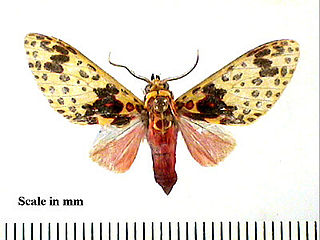
Frederick Seitz was an American physicist and a pioneer of solid state physics.

George Brackett Seitz was an American playwright, screenwriter, film actor and director. He was known for his screenplays for action serials, such as The Perils of Pauline (1914) and The Exploits of Elaine (1914).

John Francis Seitz, A.S.C. was an American cinematographer and inventor.

Amaxia is a genus of moths in the family Erebidae erected by Francis Walker in 1855. The type species of the genus is Amaxia pardalisWalker, 1855.

Bertholdia is a genus of moths in the family Erebidae.

The Sky Ranger is a 1921 American 15-episode/chapter silent film serial. Directed by George B. Seitz who also starred with June Caprice, the film serial was an adventure film with locales as exotic as Tibet. The plot staple of an inventor of aviation technology having to contend with conspirators who wish to steal the invention, often appeared in aviation films. The Sky Ranger is considered to be lost.
Franz Seitz Jr. was a German film producer, screenwriter and film director. He produced 74 films between 1951 and 2006. He was a member of the jury at the 16th Berlin International Film Festival.
Amaxia inopinata is a moth of the family Erebidae. It was described by Hervé de Toulgoët in 1989. It is found in Ecuador.
Amaxia apyga is a moth of the family Erebidae. It was described by George Hampson in 1901. It is found in Costa Rica.
Amaxia carinosa is a moth of the family Erebidae. It was described by William Schaus in 1920. It is found in Guatemala.

Amaxia chaon is a moth of the family Erebidae. It was described by Herbert Druce in 1883. It is found in Ecuador, Suriname and French Guiana.
Amaxia corata is a moth of the family Erebidae. It was described by William Schaus in 1921. It is found in Brazil.
Amaxia pardalis is a moth of the family Erebidae. It was described by Francis Walker in 1855 and is the type species of the genus Amaxia. It is found in Brazil, Suriname, Costa Rica and Mexico.
Amaxia flavicollis is a moth of the subfamily Arctiinae. It was described by Rothschild in 1909. It is found in French Guiana, the upper Amazon basin, Venezuela, Ecuador and Brazil.
Amaxia perapyga is a moth of the family Erebidae. It was described by Walter Rothschild in 1922. It is found in Brazil.
Amaxia pseudodyuna is a moth of the family Erebidae. It was described by Walter Rothschild in 1922. It is found in Brazil.
Amaxia reticulata is a moth of the family Erebidae. It was described by Walter Rothschild in 1909. It is found in French Guiana, Suriname and the Brazilian state of Amazonas.
Amaxia theon is a moth of the family Erebidae. It was described by Herbert Druce in 1900. It is found in French Guiana, Venezuela, Ecuador, Peru and Bolivia.
Amaxia violacea is a moth of the family Erebidae. It was described by Reich in 1933. It is found in Peru.
Amaxia juvenis is a moth in the family Erebidae. It was described by William Schaus in 1896. It is found in Mexico.






